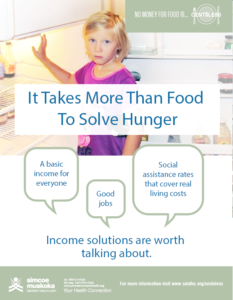Health unit highlights gulf between rich, poor
SIMCOE MUSKOKA — Local health officials are highlighting what they say is a major gulf between rich and poor in the region of responsibility.

A release Tuesday focused on new subdivisions springing up all around Tottenham.
It says the housing only making the divide between the comfortably well-off and the poorest more pronounced.
They claim that as home prices rise, there’s pressure on rents, making it harder and harder to pay for all the bills and the food each month.
And an abundance of low-income housing puts a lot of demand on the town’s little food bank.
According to them, in a town of barely 5,000 people and fewer than 2,000 households, just under 300 people make regular visits to Our Town Food Bank, says agency’s president, Robine Hawkes.
“OW (Ontario Works) isn’t enough to cover the cost of rental units,” Hawkes says.
With most of their income going to rent and the fixed costs of heat, hydro and phone, the bank account is often empty before the trip to the grocer, she points out.
Even with food bank help, clients find themselves running short of food before the next month. “They’ll come to us asking for more, and in extreme situations we will grant extensions. It’s a constant thing,” says Hawkes, who adds the food bank has been around for roughly 25 years, and yet there’s no improvement in sight.
Many of her clients have been self-employed or in part-time jobs. When illness or injury, or layoffs, take them out of the workforce, they have no savings to fall back on. They’re forced to turn to Our Town.
What Hawkes sees in Tottenham is not unique in her catchment area.
One household in eight (about 70,000 people) in Simcoe Muskoka does not have enough money to cover all the bills and pay for food at the same time, says the health unit.
Hunger pangs are the immediate issue. Poor mental and physical health at all ages and stages of life can be the result, even in childhood.
The release goes on to say: It should be no surprise that health care use and costs are also affected. For severely food insecure individuals, provincial health care spending increases up to 121% per year.
While food banks and other charitable causes help families get through short-term crisis situations, government solutions can make permanent changes for the better.
There’s proof that income supports work.
Hawkes says as soon as her clients reach their senior years and start receiving Canada Pension and Old Age Security payments, she generally stops seeing them at the food bank.
At the same time, the Nutritious Food Basket survey conducted by the health unit found that food and rent alone would have used up 86 per cent of the monthly income for a family of four on Ontario Works.
“Although food banks do their best to help people meet urgent food needs, clearly it will take much more to solve the problem of hunger once and for all,” adds public health nutritionist Jane Shrestha, with the Simcoe Muskoka District Health Unit.
“Poverty is the root cause of food insecurity and policies are needed to make sure everyone has enough money to feed themselves and their families today and every day. That’s why we have been engaged in a campaign titled ‘No Money for Food is Cent$less’.”
The health unit’s website has information devoted to the issue of food insecurity at www.smdhu.org/centsless.
For more information please call Health Connection weekdays 8:30 a.m. to 4:30 p.m. at 705-721-7520 or toll free: 1-877-721-7520.
